Download files
Complete book:
Individual page:
Thumbnail gallery: Grid view | List view

ZOOLOGY OF THE DISTRICT, 109
ZOOLOGY OF THE DISTEICT.
The range of quadrupeds is comparatively limited, em-
bracing only those common throughout the Highlands of
Scotland, and no variety is abundant. The fox, badger, and
polecat — found in considerable numbers some fifty years ago
—are rapidly disappearing through the energetic efforts of
the numerous gamekeepers, who wage a ceaseless war of ex-
termination against them, and what is more to be deplored,
against the rare and beautiful birds of prey, hawks, falcons,
jays, kites and owls, once frequently to be met with. In a
few years these will only have a traditionary existence.
They will be exterminated to make room for larger families
of grouse and partridge.
Of smaller birds there is considerable variety. The woods,
moors, sea shoi-e, marshes, and fresh water lakes, each exhibit
their peculiar tribes in more or less abundance.
Of the owl family three varieties are at least frequently
to be found — the short-eared, the white, and tawny owl.
The first frequents the neighbourhood of Lochlomond. The
other two are seen and heard occasionally in Ardencaple
woods, Rossdhu policies, and amongst the plantations bor-
dering Glen Fruin and Luss Glen.
Of smaller birds the curlew is abundant on the hills in
summer, and in flocks on the sea shore in winter. The
golden plover, the ringed plover, and red shank, also
breed on the hills above Helensburgh and Lochlomond, and
gather in flocks on the sea shore in winter. In time of snow
particularly, great numbers of the golden plover are observed
seeking a resting place and food, where the ebb tide has left
ZOOLOGY OF THE DISTEICT.
The range of quadrupeds is comparatively limited, em-
bracing only those common throughout the Highlands of
Scotland, and no variety is abundant. The fox, badger, and
polecat — found in considerable numbers some fifty years ago
—are rapidly disappearing through the energetic efforts of
the numerous gamekeepers, who wage a ceaseless war of ex-
termination against them, and what is more to be deplored,
against the rare and beautiful birds of prey, hawks, falcons,
jays, kites and owls, once frequently to be met with. In a
few years these will only have a traditionary existence.
They will be exterminated to make room for larger families
of grouse and partridge.
Of smaller birds there is considerable variety. The woods,
moors, sea shoi-e, marshes, and fresh water lakes, each exhibit
their peculiar tribes in more or less abundance.
Of the owl family three varieties are at least frequently
to be found — the short-eared, the white, and tawny owl.
The first frequents the neighbourhood of Lochlomond. The
other two are seen and heard occasionally in Ardencaple
woods, Rossdhu policies, and amongst the plantations bor-
dering Glen Fruin and Luss Glen.
Of smaller birds the curlew is abundant on the hills in
summer, and in flocks on the sea shore in winter. The
golden plover, the ringed plover, and red shank, also
breed on the hills above Helensburgh and Lochlomond, and
gather in flocks on the sea shore in winter. In time of snow
particularly, great numbers of the golden plover are observed
seeking a resting place and food, where the ebb tide has left
Set display mode to: Large image | Transcription
Images and transcriptions on this page, including medium image downloads, may be used under the Creative Commons Attribution 4.0 International Licence unless otherwise stated. ![]()
| Scottish Post Office Directories > Towns > Helensburgh > Battrum's guide and directory to Helensburgh and neighbourhood > (115) |
|---|
| Permanent URL | https://digital.nls.uk/85143166 |
|---|
| Description | Directories of individual Scottish towns and their suburbs. |
|---|
| Description | Around 700 Scottish directories published annually by the Post Office or private publishers between 1773 and 1911. Most of Scotland covered, with a focus on Edinburgh, Glasgow, Dundee and Aberdeen. Most volumes include a general directory (A-Z by surname), street directory (A-Z by street) and trade directory (A-Z by trade). |
|---|


